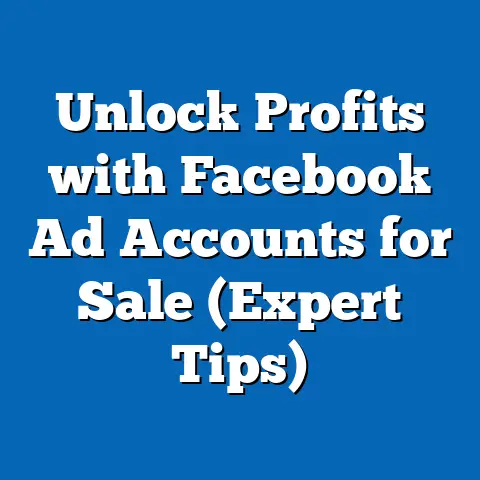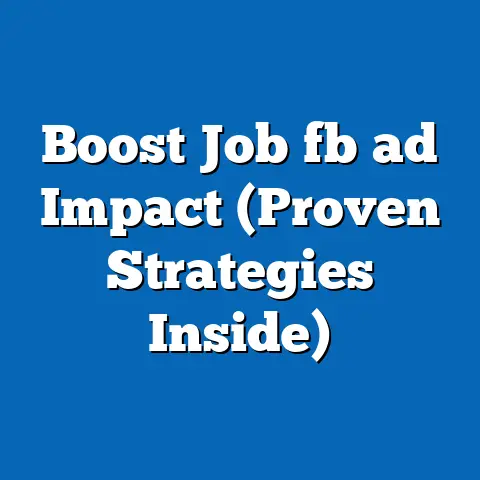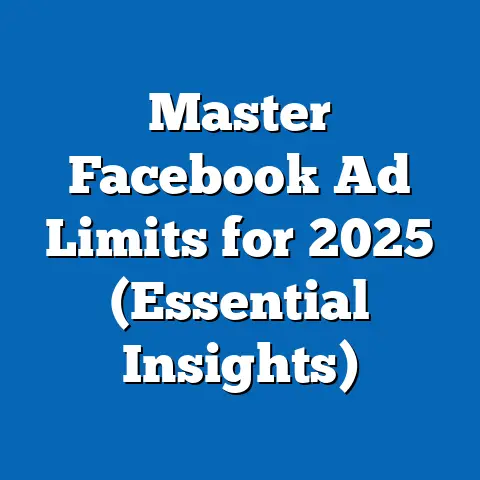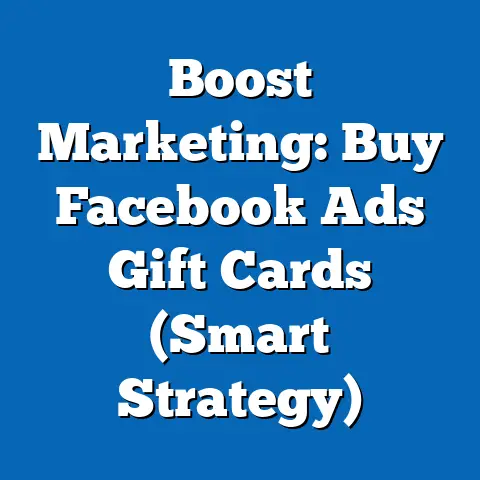Unlocking Facebook Ads vs. Boosted Posts (Expert Insights)
In today’s digital landscape, sustainability isn’t just an environmental buzzword; it’s a business imperative. Sustainable marketing is about building lasting relationships with customers, creating value that endures, and making choices that benefit both your bottom line and the long-term health of your brand. Understanding the nuances of Facebook advertising is a cornerstone of this approach. It’s not just about quick wins; it’s about building a strategy that delivers consistent results over time.
Facebook, with its billions of users, offers unparalleled opportunities for businesses to connect with their target audience. But navigating the platform’s advertising options can feel like traversing a complex maze. Two of the most common entry points are Facebook Ads and Boosted Posts. While both aim to increase visibility and engagement, they operate on fundamentally different principles.
I’ve spent years helping businesses of all sizes navigate the world of Facebook advertising. I’ve seen firsthand the power of a well-crafted ad campaign and the pitfalls of a poorly executed one. In this article, I’ll break down the key differences between Facebook Ads and Boosted Posts, offering expert insights and practical guidance to help you make informed decisions that align with your sustainable marketing goals.
Section 1: Understanding Facebook Ads
Definition and Functionality
Facebook Ads, accessed through the Ads Manager, are a sophisticated advertising system that allows you to create highly targeted campaigns with specific objectives. Think of it as your command center for reaching the right people with the right message at the right time.
The power of Facebook Ads lies in its granular targeting options. You can define your audience based on a wide range of criteria, including:
- Demographics: Age, gender, location, education, job title, and more.
- Interests: Hobbies, passions, and the content they engage with on Facebook.
- Behaviors: Purchase history, online activities, and device usage.
- Custom Audiences: Upload your own customer lists or create lookalike audiences based on existing customers.
Facebook Ads also offer a diverse range of ad formats to suit your message and target audience. Some popular options include:
- Image Ads: Single image with text, ideal for simple and visually appealing messages.
- Video Ads: Engaging video content that captures attention and tells a story.
- Carousel Ads: Showcase multiple products or features with a series of images or videos.
- Slideshow Ads: Create a video-like experience using a series of still images.
- Collection Ads: Visually immersive format that allows users to browse and purchase products directly from the ad.
- Lead Ads: Capture leads directly within Facebook, making it easy for users to provide their information.
Finally, Facebook Ads provide a wealth of placement options, allowing you to reach your audience across the Facebook ecosystem, including:
- News Feed: The primary feed where users see updates from friends, family, and businesses.
- Instagram Feed: Reach users on Instagram with visually appealing ads.
- Facebook Marketplace: Target users who are actively browsing and buying products.
- Facebook Stories: Engage users with short-form, immersive content in Stories.
- Instagram Stories: Expand your reach to Instagram users through Stories.
- Audience Network: Extend your reach beyond Facebook and Instagram to a network of mobile apps and websites.
Benefits of Facebook Ads
The benefits of using Facebook Ads are numerous, making them a powerful tool for achieving a wide range of business goals.
- Precise Targeting: As mentioned earlier, the ability to target specific audiences based on demographics, interests, and behaviors is a game-changer. This ensures that your ads are seen by people who are most likely to be interested in your products or services.
- Detailed Analytics and Tracking: Facebook Ads Manager provides comprehensive data on your campaign performance, including impressions, reach, clicks, conversions, and cost per result. This allows you to track your ROI and make data-driven decisions to optimize your campaigns. I’ve personally used this data to pivot campaigns that weren’t performing as expected, saving significant budget in the process.
- Wide Range of Objectives: Facebook Ads support a variety of campaign objectives, including brand awareness, reach, traffic, engagement, lead generation, app installs, video views, and conversions. This allows you to tailor your campaigns to specific goals, whether you’re looking to build brand awareness, generate leads, or drive sales.
- Scalability: Facebook Ads can be scaled to reach larger audiences and generate more results as your budget and business grow. You can gradually increase your budget and expand your targeting to reach new customers.
- A/B Testing: Experiment with different ad creatives, targeting options, and placements to identify what works best for your audience. This allows you to continuously improve your campaigns and maximize your ROI.
Section 2: Exploring Boosted Posts
Definition and Purpose
Boosted Posts are essentially regular Facebook posts that you pay to promote to a wider audience. They’re a simpler, more streamlined way to increase the visibility of your content compared to Facebook Ads. You can boost existing posts directly from your Facebook Page, selecting a target audience and budget.
The primary purpose of a Boosted Post is to increase engagement and reach a larger audience than your organic posts typically achieve. It’s a quick and easy way to get your content seen by more people, especially those who don’t already follow your page.
Benefits of Boosted Posts
While Boosted Posts lack the sophistication of Facebook Ads, they offer several advantages, particularly for businesses looking for a quick and easy way to promote their content.
- Ease of Use: Boosting a post is incredibly simple. You can do it directly from your Facebook Page in just a few clicks. This makes it an appealing option for businesses that don’t have the time or resources to create complex ad campaigns.
- Increased Visibility for Existing Content: Boosted Posts are a great way to get more eyes on content you’ve already created, such as blog posts, videos, or event announcements. This can help you drive traffic to your website, increase brand awareness, and generate leads.
- Affordability: Boosted Posts can be a cost-effective way to reach a larger audience, especially for small businesses with limited budgets. You can set your budget and duration for the boost, giving you control over your spending.
- Reach Local Audiences: Boosted Posts are particularly effective for reaching local audiences and promoting events or offers in your area. You can target users based on their location and interests, making it a great way to connect with potential customers in your community. I remember a local bakery that used boosted posts to promote their daily specials, and they saw a significant increase in foot traffic as a result.
- Quick Results: Boosted Posts can deliver quick results in terms of increased engagement and reach. This makes them a good option for time-sensitive promotions or events.
Section 3: Key Differences Between Facebook Ads and Boosted Posts
While both Facebook Ads and Boosted Posts serve the purpose of increasing visibility and engagement, the core differences lie in their functionality, targeting options, and overall effectiveness.
Targeting Options
This is where the biggest difference lies. Boosted Posts offer limited targeting options, primarily focusing on:
- Location: Target users within a specific geographic area.
- Interests: Select a few broad interest categories.
- Age and Gender: Define the age range and gender of your target audience.
- People who like your Page and their friends: Reach your existing followers and their network.
Facebook Ads, on the other hand, offer a much wider array of targeting options, allowing you to create highly specific audiences based on demographics, interests, behaviors, custom audiences, and lookalike audiences. This level of granularity allows you to target the right people, not just more people.
Ad Objectives
Boosted Posts are primarily focused on increasing engagement and reach. The objectives you can choose from are limited to:
- Engagement: Get more reactions, comments, and shares on your post.
- Website Visits: Drive traffic to your website.
- Messages: Encourage users to send you messages.
Facebook Ads offer a much broader range of objectives, allowing you to align your campaigns with specific business goals. These objectives include:
- Awareness: Increase brand awareness and reach a wider audience.
- Traffic: Drive traffic to your website or app.
- Engagement: Get more page likes, post engagement, or event responses.
- Leads: Generate leads through lead forms or Messenger.
- App Promotion: Promote your app and drive downloads.
- Sales: Drive online sales or in-store visits.
Cost Structure
The cost structure for Facebook Ads and Boosted Posts is also different. Boosted Posts typically have a lower entry cost, making them an appealing option for businesses with limited budgets. You can set your budget and duration for the boost, giving you control over your spending.
Facebook Ads can require a larger budget, especially for more complex campaigns with advanced targeting options. However, they also offer more granular control over spending. You can set daily or lifetime budgets, bid strategies, and ad schedules to optimize your ROI.
Here’s a table summarizing the key differences:
| Feature | Facebook Ads | Boosted Posts |
|---|---|---|
| Targeting Options | Highly granular, demographics, interests, behaviors, custom audiences, etc. | Limited, location, interests, age, gender, followers and their friends |
| Ad Objectives | Wide range, awareness, traffic, engagement, leads, sales, etc. | Limited, engagement, website visits, messages |
| Cost Structure | Can be higher, but offers more control over spending | Lower entry cost, but less control over optimization |
| Complexity | More complex, requires understanding of Ads Manager | Simpler, easier to set up directly from Facebook Page |
| Analytics | Detailed analytics and tracking capabilities | Limited analytics |
| Feature | Facebook Ads | Boosted Posts |
|---|---|---|
| Targeting Options | Highly granular, demographics, interests, behaviors, custom audiences, etc. | Limited, location, interests, age, gender, followers and their friends |
| Ad Objectives | Wide range, awareness, traffic, engagement, leads, sales, etc. | Limited, engagement, website visits, messages |
| Cost Structure | Can be higher, but offers more control over spending | Lower entry cost, but less control over optimization |
| Complexity | More complex, requires understanding of Ads Manager | Simpler, easier to set up directly from Facebook Page |
| Analytics | Detailed analytics and tracking capabilities | Limited analytics |
Section 4: When to Use Facebook Ads vs. Boosted Posts
Choosing between Facebook Ads and Boosted Posts depends on your specific goals, budget, and resources. Here are some scenarios where each option might be the best choice:
When to Use Facebook Ads:
- You have specific business goals beyond just engagement: If you’re looking to generate leads, drive sales, or promote your app, Facebook Ads are the way to go.
- You need precise targeting: If you want to reach a very specific audience based on demographics, interests, or behaviors, Facebook Ads offer the targeting options you need.
- You have a dedicated marketing team or agency: Managing Facebook Ads campaigns can be time-consuming and requires expertise. If you have a dedicated team or agency, you can leverage their skills to create and optimize effective campaigns.
- You want to track your ROI: Facebook Ads Manager provides detailed analytics and tracking capabilities, allowing you to measure your ROI and make data-driven decisions.
- You’re running a long-term campaign: Facebook Ads are better suited for long-term campaigns that require ongoing optimization and adjustments.
When to Use Boosted Posts:
- You want a quick and easy way to increase visibility: If you’re looking for a simple way to get more eyes on your content, Boosted Posts are a good option.
- You’re on a tight budget: Boosted Posts can be a cost-effective way to reach a larger audience, especially for small businesses with limited budgets.
- You want to reach a local audience: Boosted Posts are particularly effective for reaching local audiences and promoting events or offers in your area.
- You’re promoting a time-sensitive event or offer: Boosted Posts can deliver quick results in terms of increased engagement and reach, making them a good option for time-sensitive promotions.
- You’re new to Facebook advertising: Boosted Posts are a good starting point for businesses that are new to Facebook advertising. They’re easy to set up and manage, allowing you to get your feet wet without getting overwhelmed.
Expert Opinions
I asked Sarah Jones, a seasoned digital marketing consultant, for her take: “Boosted Posts are great for local businesses wanting a quick visibility boost, but for serious campaigns with specific goals, Facebook Ads are essential. The targeting and tracking are just unmatched.”
Another expert, Mark Lee, added, “Think of Boosted Posts as dipping your toes in the water, and Facebook Ads as diving into the deep end. Both have their place, but knowing the difference is crucial for maximizing your marketing spend.”
Conclusion
In the ever-evolving world of Facebook advertising, understanding the nuances between Facebook Ads and Boosted Posts is essential for achieving your marketing goals. Boosted Posts offer a quick and easy way to increase visibility and engagement, while Facebook Ads provide a more sophisticated and targeted approach. Both can play a valuable role in a comprehensive social media marketing strategy, but knowing when to use each option is key.
As you navigate the world of Facebook advertising, remember to prioritize sustainable marketing practices. Focus on building lasting relationships with your customers, creating value that endures, and making choices that benefit both your bottom line and the long-term health of your brand. By making informed decisions about your Facebook advertising strategy, you can contribute to the sustainable growth and success of your business. Whether it’s through meticulously crafted ad campaigns or strategically boosted posts, every effort counts towards building a brand that resonates and endures.





